Concrete Laminate: Applications and Benefits in Design
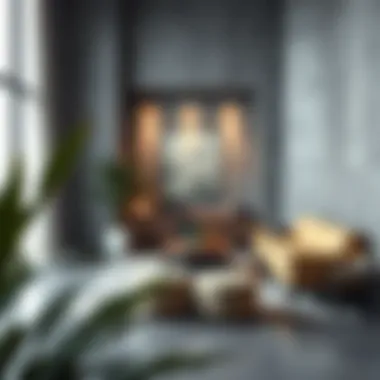

Intro
Concrete laminate is making waves in the realm of contemporary interior design. This innovative material combines the robust nature of concrete with the sleek, stylish elements of laminate, providing a unique solution for a variety of design needs. As designers and homeowners alike seek to strike a balance between functionality and aesthetics, concrete laminate emerges as a strong contender.
This article explores its many facets—from composition and applications to installation and maintenance. It aims to illuminate the reasons for the growing popularity of concrete laminate, helping readers understand why this material is not just a trend, but a practical choice for modern living spaces.
With an eye on both beauty and utility, let’s dive deep into the world of concrete laminate.
Furniture Design Trends
When it comes to furniture design, trends are often influenced by social, cultural, and environmental factors. Concrete laminate fits beautifully into current styles, merging functionality with a contemporary flair.
Current Styles and Themes
The use of concrete laminate aligns well with various design themes, including minimalism and industrial style. In minimalist spaces, its clean lines and muted textures contribute to uncluttered aesthetics. Conversely, in industrial-themed settings, it complements raw materials like exposed brick and metal, creating a striking contrast that is both stylish and inviting.
More adventurous designers are integrating concrete laminate to play with textures. Pairing smooth surfaces with rougher wood or metal accents offers a dynamic balance that catches the eye.
Color Palettes and Materials
Concrete laminate comes in a rich palette of colors, often reflecting natural hues such as grays, browns, and earthy tones. This versatile color range makes it easy to incorporate into existing decor, whether one prefers a monochromatic look or a bolder color palette. It can be paired with pastel colors to evoke a softer feel or contrasted with darker tones for a more dramatic effect.
The materials that complement concrete laminate are abundant. Think along the lines of natural wood, which adds warmth, or metal elements that enhance its modern appeal. From toolboxes to chairs, the options are endless.
"Concrete laminate is a palette of potential, where creativity meets durability."
Practical Furniture Tips
When selecting and maintaining concrete laminate furnishings, there are several factors to consider to ensure long-lasting beauty and utility.
How to Choose the Right Size
Choosing the right size for furniture made from concrete laminate is crucial. First off, measure your space and leave room for movement. For instance, in smaller rooms, one might opt for a streamlined coffee table rather than a bulky dining piece. Additionally, consider the proportion of your existing furniture; balance is key.
Maintenance and Care for Longevity
Concrete laminate is relatively low-maintenance, which is a significant draw for many people. To keep it looking fresh:
- Wipe surfaces regularly with a damp cloth to remove dust and spills.
- Avoid harsh chemicals that can damage the finish.
- Consider using coasters for beverages to prevent rings.
For deep grime, a mild soap solution works wonders. Regular upkeep ensures your furniture remains an admired centerpiece for years to come.
Prelude to Concrete Laminate
In the realm of contemporary design, concrete laminate emerges as more than just a surface treatment; it symbolizes a shift toward integrating durability with aesthetic flexibility. With the rise of minimalist lifestyles and urban living spaces, concrete laminate has carved a niche, becoming a substantial element for homeowners and designers alike. Understanding this material is akin to unlocking the door to a new world of decor possibilities.
Defining Concrete Laminate
Concrete laminate refers to a composite material that combines layers of concrete with various resins and aggregates, creating a versatile surface that mimics the essence of solid concrete while offering additional benefits. The laminate process involves layering, which not only enhances the visual appeal but also contributes to its lightweight nature. As a result, this material can be applied in various settings—from sleek countertops to striking wall panels—bridging the gap between functionality and style.
Origins and Development
The roots of concrete laminate trace back several decades, yet its popularity surged in recent years. Initially, designers favored traditional materials like hardwood or natural stone, but the evolving landscape of high-performance materials saw the rise of concrete laminate. Innovations in manufacturing processes, particularly advancements in polymer technology, led to this material’s emergence as a viable alternative. Concrete laminate now offers an extensive range of patterns, colors, and textures, emulating not just concrete but a myriad of surfaces.
Key Characteristics
Concrete laminate brings to the table a handful of defining characteristics that make it a go-to choice for modern projects:
- Durability: Resilient against wear and tear, making it suitable for high-traffic areas.
- Aesthetic Flexibility: Available in diverse designs, enhancing both contemporary and traditional interiors.
- Ease of Maintenance: Generally resistant to stains and easy to clean, saving time and effort for homeowners.
- Lightweight: Unlike traditional concrete structures, laminate versions are considerably lighter, simplifying installation and application.
"Concrete laminate transcends the ordinary, serving not just as a surface, but as a statement of personality and design in any space."
With such a robust profile, concrete laminate serves as a foundation for innovation in design, beckoning both DIY enthusiasts and seasoned professionals to explore its myriad applications. The following sections will delve deeper into the materials, applications, and advantages that further spotlight this remarkable material.
Materials Used in Concrete Laminate
Materials form the backbone of concrete laminate, directly influencing its performance, durability, and overall appeal. Understanding the materials involved gives designers and homeowners insight into how these elements contribute to the effectiveness and versatility of the product. This section will break down the key components of concrete laminate, focusing on their specific roles and benefits.
Composition Overview
Concrete laminate is an innovative blend of raw materials, primarily comprised of cement, aggregates, and various resins that bind these components together. The composition of concrete laminate can significantly affect its texture, finish, and overall structural integrity. Unlike traditional concrete, which tends to be heavy and more labor-intensive, concrete laminate offers a lighter and more adaptable option, making it suitable for various applications.
- Cement: Acts as the primary binding agent. It provides strength and stability.
- Aggregates: These come in various sizes and types, impacting the surface texture and weight of the final product. Common aggregates include sand, gravel, and crushed stone.
- Resins: Crucial for enhancing the flexibility and durability of the laminate. They allow for fewer cracks and improve resistance against environmental factors.
- Dyes and Pigments: Used for coloring purposes, providing a range of aesthetic choices to suit any design preference.
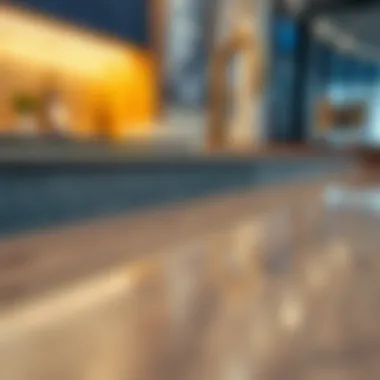

By highlighting the interplay between these components, designers can make informed decisions on how to use concrete laminate effectively in modern design.
Types of Resins and Aggregates
When discussing concrete laminate, resins and aggregates play a vital role. Their respective properties can make or break the performance and appearance of concrete laminate. Let's delve into each type, including their unique characteristics and why they are popular choices within the concrete laminate world.
Polyester
Polyester resin serves as a cost-effective solution for concrete laminate applications. Its notable quick curing time expedites the construction or remodeling process, making it a sought-after option for both commercial and residential designs. One key characteristic of polyester is its flexibility, allowing it to adapt to different mold shapes without compromising structural integrity.
- Advantages: It offers a good balance of durability and affordability, appealing to budget-conscious homeowners and builders. The ready availability of polyester resin enhances its popularity in many markets.
- Disadvantages: While it does well in many applications, polyester is not as heat-resistant as some alternatives, which might limit its use in high-temperature environments.
Epoxy
Epoxy resins are celebrated for their strength and superior adhesion properties. This material is particularly beneficial when creating thicker panels or intricate designs. One of the defining characteristics of epoxy is its high resistance to chemical exposure, making it ideal for spaces like kitchens or laboratories where accidents can happen.
- Advantages: Epoxy provides a durable and long-lasting solution, leading to fewer repairs or replacements over time. Its aesthetic appeal allows for vibrant color options and finishes that can enhance various design schemes.
- Disadvantages: The cost of epoxy tends to be higher than that of polyester, which might deter some homeowners or decorators looking for budget-friendly choices.
Recycled Materials
Using recycled materials in concrete laminate is growing more popular, aligning with the global push for sustainability and eco-friendly practices. Incorporating glass or plastic waste not only reduces environmental impact but also enables innovative design possibilities. A standout characteristic of recycled materials is their versatility; they can be processed in various ways to achieve different finishes and styles.
- Advantages: This approach greatly lowers the carbon footprint associated with traditional concrete production. Moreover, consumers are increasingly drawn to eco-conscious choices, making recycled concrete laminate an excellent selling point.
- Disadvantages: The processing of recycled materials may encounter challenges. For instance, there can be variability in quality and strength, making it crucial for manufacturers to establish stringent quality control measures.
In summary, the materials utilized in concrete laminate reflect a balance between functional performance, aesthetic versatility, and environmental considerations. Each element serves a purpose that echoes the demands and preferences of contemporary design.
For more information on concrete materials and their applications, consider visiting Wikipedia on Concrete, or explore design inspiration at sites like Houzz.
Applications of Concrete Laminate
Understanding the applications of concrete laminate is crucial to grasp its significance in modern design. This material serves not just as a functional item but also shapes the aesthetic landscape of various spaces. Its versatility allows it to blend into diverse environments, making it popular among homeowners, interior decorators, and designers alike. Employing concrete laminate can enhance durability, design, and overall functionality in residential and commercial settings.
Residential Uses
Kitchens
Kitchens are often considered the heart of the home, where families gather to cook, share meals, and create memories. Concrete laminate in kitchens offers a strong durable surface that withstands spills and scratches making it a wise choice for busy households. Its heat resistance is notably advantageous, as it can tolerate the temperature fluctuations common in cooking without losing its charm.
Moreover, with the broad range of designs and textures available, concrete laminate can mimic the look of high-end materials such as marble or granite without the hefty price tag. It's easy to clean and maintain, making it hurtle ahead in popularity among designers who seek both style and practicality.
Bathrooms
Bathroom environments demand materials that resist moisture and humidity. Concrete laminate checks this box effectively. The water-resistant properties of concrete laminate make it a terrific candidate for this space, ensuring that surfaces do not buckle or warp over time. In terms of style, it brings a contemporary look that can transform a mundane bathroom into a sleek sanctuary.
In addition, most bathroom designs prioritize easy maintenance, and this is where concrete laminate shines again. The surface can be cleaned quickly and efficiently, guarding against the growth of mold and mildew, giving homeowners peace of mind.
Flooring
Concrete laminate flooring is gaining traction due to its overall durability. Unlike traditional wood flooring, it doesn’t scratch easily and can bear heavy foot traffic. This quality ensures a longer lifespan, making it a cost-effective choice in the long run. The ability to achieve different finishes allows homeowners to maintain a specific aesthetic, whether rustic, modern, or industrial.
However, while its durability is a key selling point, one should note that concrete laminate can feel cold underfoot, especially during colder months. Homeowners may need to consider area rugs or heating solutions to mitigate this downside. Overall, its strength, ease of maintenance, and aesthetic versatility make it a strong contender in residential flooring.
Commercial Applications
Retail Spaces
In retail, first impressions mean everything. Concrete laminate provides the opportunity to create striking visuals while maintaining functional flooring and surfaces. The robust nature of concrete laminate handles the stresses of a bustling retail environment, from high-heeled shoes to heavy carts. Retailers often look for materials that can withstand constant foot traffic while also being easy to clean; once again, concrete laminate ticks these boxes. Moreover, its ability to be customized means that a store can establish a distinctive brand identity through carefully chosen colors and textures.
Restaurants
Restaurants are unique spaces where ambiance and durability must coexist. The versatility of concrete laminate allows it to be used for tabletops, bar counters, and flooring. With kitchens constantly at work, surfaces must be able to resist heat, spills, and stains, and this material serves admirably in such conditions. Notably, concrete laminate can handle the artistic expression restaurants desire, allowing for unique countertop designs that can complement a theme or menu.
However, it's important to choose the right finish; while some textures may appear more upscale, others may come off as more utilitarian, which can affect the overall dining experience.
Offices
Changing how employees interact with their workspace is vital for productivity. Concrete laminate offers a modern, clean aesthetic that can improve office environments. Its low-maintenance attributes and resistance to wear make it suitable for high-traffic areas where desks, chairs, and equipment are frequently moved. Furthermore, with the growing trend of open office layouts, designers can capitalize on the limitless design possibilities provided by concrete laminate, as it easily adapts to different styles so can fit seamlessly into contemporary office spaces.
Advantages of Concrete Laminate
Concrete laminate has carved a niche for itself in modern design, offering numerous benefits that capture the attention of homeowners and designers alike. Understanding these advantages is key in appreciating why this material has surged in popularity. Key points include its durability, aesthetic flexibility, and cost efficiency—all crucial elements for anyone looking to make informed choices about their living or working spaces.
Durability and Longevity
When it comes to durability, concrete laminate stands as a titan in the material world. This laminate is engineered specifically to endure wear and tear, making it ideal not only for residential use but also in commercial settings where foot traffic is heavy. Think of it this way: while a standard wood laminate might buckle at the first sign of moisture, concrete laminate doesn’t flinch. It can withstand water, stains, and impacts far better than its counterparts, which means fewer repairs and replacements down the line.
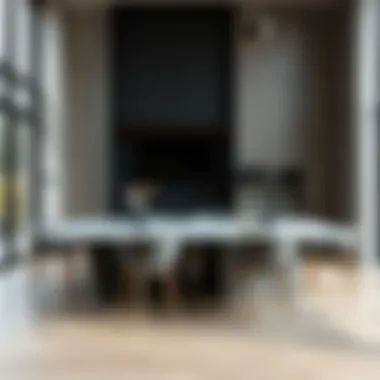
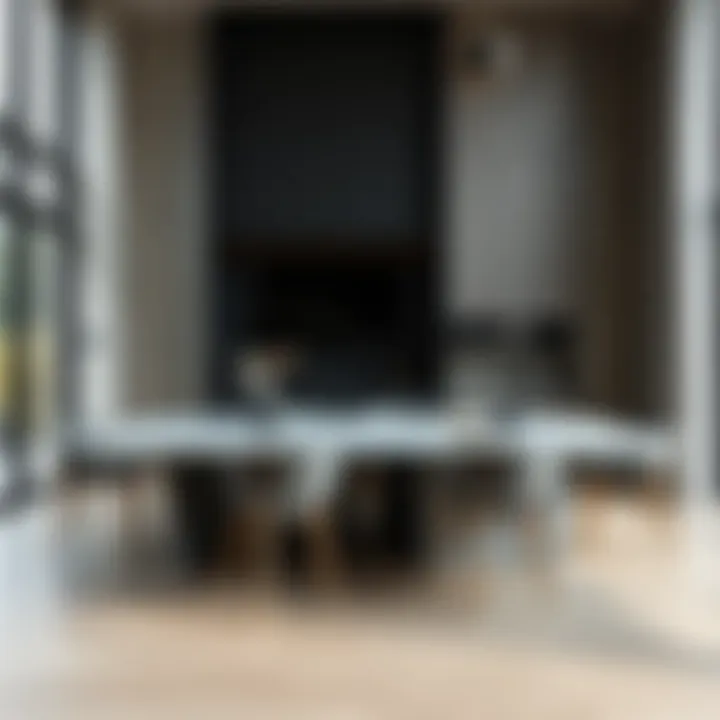
The resilience also makes it suitable for outdoor use, exposing it to various weather conditions without significant degradation. Concrete laminates can last for decades, often outpacing traditional materials in lifespan. It's not just about immediate beauty but ensuring long-term reliability, giving users the freedom to enjoy their spaces without constant concern over maintenance.
Aesthetic Versatility
One of the most appealing aspects of concrete laminate is its versatility in aesthetics. This material can emulate a myriad of looks, from sleek modern designs to rustic and industrial finishes. Homeowners and designers can choose from various colors, textures, and patterns, allowing seamless integration into diverse decor styles. You walk into a room with a concrete laminate, and you might be hard-pressed to identify it as laminate at all.
Whether it’s a chic concrete-look kitchen countertop or a warm, wood-textured flooring, the design possibilities are virtually endless. This flexibility is particularly advantageous for interior decorators looking to create unique spaces that resonate with the occupants. The ability to customize finishes means that no two projects need to look alike. No wonder this material has caught the eye of DIY enthusiasts eager to put a personal stamp on their projects!
Cost-Effectiveness
Cost considerations often weigh heavily on decision-making, and this is where concrete laminate shines brightly. While the initial investment may seem a bit steeper than traditional materials, the long-term savings are worth every penny. Given its durability, the frequency of repairs and replacements drops significantly, which leads to lower overall costs. Additionally, the ease of installation can sometimes translate to reduced labor costs, adding further economic benefit.
Imagine renovating a space: the durability of concrete laminate ensures that you won’t be redoing the same renovations every few years, thus freeing up both time and money for other endeavors. For residential or commercial projects, leaning towards concrete laminate could be a wise decision financially, marrying top-notch quality with smart budgeting.
"Investing in quality materials is like planting a seed: the returns come back tenfold once rooted in durability and function."
By considering these advantages, you're well on your way to transforming spaces with a material that combines practicality with design flair.
Installation Processes
The installation of concrete laminate is a critical phase in harnessing its potential for enhancing spaces. Understanding the intricacies involved not only ensures optimal application but also maximizes the benefits that come along with this innovative material. A well-executed installation guarantees durability and aesthetic appeal, making it a worthwhile investment for homeowners and designers alike.
Preparation and Planning
Before embarking on the actual installation journey, a thorough preparatory phase is essential. This stage is like laying the groundwork for a sturdy structure; if the foundation is flawed, the end result may disappoint.
- Assessment of the Space: Take time to examine the area where the laminate will be installed. Consider the temperature, humidity levels, and existing flooring to decide if the time is right.
- Choosing the Right Material: Not all concrete laminates are created equal. Different finishes, colors, and textures can drastically alter the ambiance of a space. Pick one that reflects the desired aesthetic.
- Calculating Requirements: Measure the area accurately to determine how much material will be needed. Anticipating waste due to cuts or errors can save headaches later.
- Gathering Tools and Supplies: Having all necessary tools ready is a game-changer. You'll typically need a trowel, leveling compound, saw, and adhesive, among other items.
- Setting a Timeline: Plan out how long the entire process may take. This helps in budgeting time, especially if you’re coordinating with contractors or other workers.
This careful prep work lays the groundwork for smooth sailing during installation. It's akin to an artist sketching a canvas before painting; without this initial outline, the end product risks falling flat.
Step-by-Step Installation Guide
Once the planning is in place, it’s time to roll up the sleeves and get into the nitty-gritty of installation. As with any craft, a step-by-step guide can simplify the intricacies involved, ensuring that each detail is attended to meticulously. Here’s a straightforward process to follow:
- Surface Preparation: Begin by cleaning the surface to remove any dust or debris. Ensure it’s level and smooth to avoid imperfections in the laminate.
- Layout Planning: Before adhering the laminate, lay down a few pieces to visualize how they fit together. This helps in making adjustments if necessary.
- Applying Adhesive: Once satisfied with the layout, apply the adhesive evenly on the surface. Be sure to follow the manufacturer’s recommendations for proper application.
- Positioning the Tiles: Carefully place the laminate onto the adhesive, pressing firmly to ensure a secure bond. It’s vital to maintain alignment, as shifts can lead to undesired gaps.
- Cutting Panels: If you reach areas that require cutting for edges or corners, measure and mark neatly, then use a saw to make precise cuts.
- Securing the Edges: After installation, make sure all edges are well secured. A proper finish seals the laminate and prevents moisture entry, which could cause damage over time.
- Curing Time: Lastly, allow the adhesive to cure according to the instructions. It’s best not to rush this part; a well-cured laminate enhances durability and longevity.
This step-by-step method not only facilitates a successful installation but also instills confidence in those undertaking the task, whether they are seasoned professionals or enthusiastic DIYers.
"A well-planned installation can be the difference between a satisfactory finish and a stunning transformation in your space."
With proper installation, the benefits of concrete laminate can truly shine, providing both aesthetic appeal and functionality in equal measure. For further reading and insights on construction and material application, resources like Wikipedia and Britannica provide extensive information.
Maintenance Considerations
When it comes to maintaining concrete laminate surfaces, the importance cannot be overstated. Proper maintenance not only extends the lifespan of the material but also ensures that it continues to look as pristine as the day it was installed. Concrete laminate, while sturdy, does require some attention to keep it in tip-top shape. This section focuses on specific elements that contribute to the longevity and appearance of concrete laminate in various settings.
Cleaning Techniques
Routine cleaning is one of the cornerstones of maintaining concrete laminate. Although it is a resilient material, a bit of TLC goes a long way. Here are some tried and true cleaning methods:
- Dust and Sweep Regularly: Just like you wouldn’t leave your favorite shirt lying in the dusty corner, keeping concrete laminate dust-free is critical. A quick sweep or dusting can prevent particles from scratching the surface.
- Use Mild Detergents: For deeper cleaning, a solution of warm water and a few drops of mild detergent does wonders. Avoid harsh chemicals that could damage the laminate's finish. Remember, less is often more when it comes to cleaning agents!
- Microfiber Cloths are Your Best Friend: Using a soft cloth, specifically a microfiber one, is a smart move. It lifts dirt without leaving scratches
- Sealing for Extra Protection: Although not a cleaning method per se, applying a sealant can help safeguard against stains and make regular cleaning easier. Remind yourself every few years to refresh the sealant.
"Regular care of concrete laminate will ensure its durability and keeping it looking great."
Avoiding Damage
Just as important as cleaning is safeguarding concrete laminate from potential damage. Here are a few practical strategies to avoid unintentional harm:
- Avoid Heavy Impacts: While concrete laminate is tough, it is not indestructible. Be mindful when moving heavy furniture or appliances. Using furniture pads can both protect the surface and make moving them easier.
- Watch Out for Hot Objects: Placing a hot pot directly on the surface can lead to discoloration and damage. A simple solution is to always use trivets or hot pads.
- Steer Clear of Sharp Objects: As tempting as it may be to use the surface for cutting or other tasks, always employ a cutting board to protect against scratches.
- Regular Inspections: Every so often, take a good look at your concrete laminate for signs of wear or damage. Catching issues early can save you a lot of hassles down the road.
By following these cleaning and damage-avoidance techniques, homeowners and designers can ensure that concrete laminate remains a shining star in both residential and commercial spaces.
Environmental Considerations
In today’s era, the conversation surrounding environmental sustainability is more critical than ever. As homeowners and designers alike strive for greener choices in materials, concrete laminate emerges as a viable option. This section sheds light on the environmental considerations associated with this innovative material, particularly its sustainability and recyclability. These two aspects contribute significantly not just to reducing the carbon footprint but also to conserving natural resources and promoting a circular economy.
Sustainability of Materials
The concept of sustainability, particularly concerning materials, revolves around using resources in a manner that meets current needs without compromising the ability of future generations to meet theirs. Concrete laminate is made using locally sourced materials that help minimize transportation emissions. Moreover, many manufacturers are adopting practices that involve the use of recycled content in their production processes.
- Reduced Carbon Footprint: Since concrete laminate can be produced closer to its point of use, transportation-related environmental impact decreases. This practice not only reduces costs but also lessens greenhouse gas emissions.
- Long-lasting Durability: With a lifespan potentially exceeding a decade or more, concrete laminate’s durability cuts down on the need for frequent replacements. This aspect translates to lesser waste generated over time.
- Low Maintenance Needs: The material's inherent strength means it requires minimal upkeep. Less frequent maintenance translates into lower resource consumption for cleaning, repairs, and replacements.
Given these factors, choosing concrete laminate can indeed be a step in the right direction for environmentally conscious consumers. As the adage goes, “waste not, want not,” which perfectly encapsulates why sustainable choices matter.
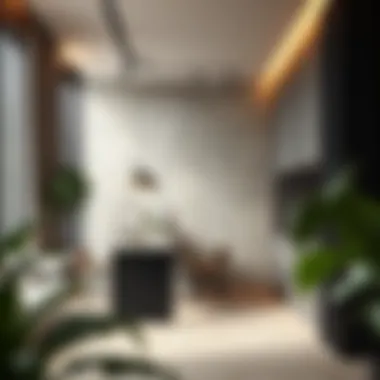
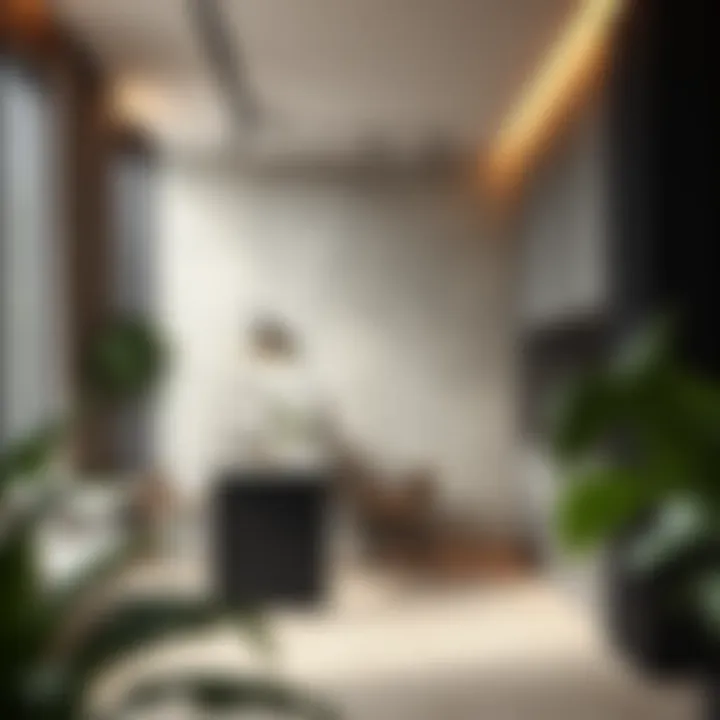
Recyclability of Concrete Laminate
In line with sustainability, the recyclability of concrete laminate should not be overlooked. Being able to reclaim and reprocess materials at the end of their life cycle plays a pivotal role in reducing construction waste.
- Closed-loop System: Most concrete laminates can be repurposed into new products, minimizing landfill use. Some companies are pioneering methods that allow for the recycling of old laminate back into new production processes, thus creating a closed-loop material model.
- Alternative Uses: Once removed, old concrete laminate can be crushed and used in aggregate for new concrete or as part of landscaping features. This flexibility not only prevents waste but also contributes to a more sustainable construction practice.
- Certifications: Look out for certifications from organizations such as the U.S. Green Building Council, which offer assurance that the concrete laminate is sourced and processed responsibly.
"Recycling is not a luxury; it’s an imperative. Every piece counts in shaping a greener future."
The scope of recognizing concrete laminate’s recyclability can transform how we think about waste in the industry. Homeowners and designers alike can take pride in using materials that contribute to a sustainable environment.
Comparative Analysis with Other Materials
In the dialogue about modern building materials, comparing concrete laminate to its counterparts is crucial for understanding its unique position in contemporary design. This section illuminates how concrete laminate stacks up against both traditional wood laminate and natural stone, shedding light on the specific advantages it brings to the table, as well as its limitations.
Concrete vs. Traditional Wood Laminate
When one pits concrete laminate against traditional wood laminate, the contrast is not just about aesthetics but extends to functionality and durability. The allure of wood is hard to resist; it brings warmth, richness, and character to any space. However, wood has its vulnerabilities. It can warp, stain, or sustain damage due to moisture or heavy foot traffic.
Conversely, concrete laminate demonstrates a robust character. It resists scratching, fading, and even fire, making it a more resilient choice for high-traffic areas. These properties are not merely theoretical; many homeowners transitioning from conventional wood to concrete laminate find themselves appreciating the ease of maintenance it offers. A simple wipe with a damp cloth is often enough to restore its charm, whereas wood typically requires more rigorous and frequent care.
The durability of concrete laminate over traditional wood offers long-term savings, as homeowners will spend less on repairs and replacements.
A noteworthy point in favor of concrete laminate is its aesthetic versatility. It can mimic the appearance of wood, allowing users to enjoy the beauty of natural textures without sacrificing durability. Additionally, the eco-friendly options in concrete laminate, often made from recycled materials, can resonate better with a sustainability-conscious audience.
Concrete Laminate vs. Natural Stone
Natural stone has long been celebrated for its timeless elegance; however, it comes with its own set of challenges. Firstly, the weight of stone can complicate installation, often requiring additional structural support. Furthermore, the cost associated with natural stone can be prohibitive, making it less accessible for typical projects.
In contrast, concrete laminate presents a lighter and more cost-effective solution while providing a similar aesthetic. While stones like marble or granite have a grandeur that is hard to replicate, modern concrete laminate can achieve that luxurious look without the hefty price tag. The customizability of concrete laminate is another feather in its cap—colors, textures, and finishes can be tailored to fit virtually any design schema.
Form a practical standpoint; concrete laminate scores high on maintenance as well. Natural stone often needs regular sealing to prevent staining and scratching. Conversely, concrete laminate requires far less upkeep, and its resistance to stains makes it ideal for kitchens and bathrooms.
In a nutshell, while natural stone is striking, concrete laminate’s durability, customizability, and cost-effectiveness are hard to overlook. Each material has its merits, but for a growing number of designers and homeowners, the benefits of concrete laminate seem to outweigh the appeal of both wood and stone, making it a frontrunner for modern interiors.
Case Studies and Design Inspirations
The exploration of case studies and design inspirations is crucial to understanding the practical application of concrete laminate in real-world scenarios. Through these examples, one can witness the unique ways this versatile material has been integrated into various architectures and interiors, reshaping conventional design perspectives. This section will unravel innovative uses and inspiring transformations, demonstrating how homeowners, designers, and decorators can harness the attributes of concrete laminate.
Innovative Residential Designs
In the realm of residential spaces, concrete laminate has emerged as a game-changer. One such notable instance is the renovation of a traditional urban loft in New York City, where concrete laminate was employed to create a seamless flow between spaces. The design cleverly used thick concrete slabs in the kitchen and living areas, providing a rugged yet refined aesthetic that complements modern industrial style. This design choice not only showcases the material’s durability but also enhances the visual appeal of the open-concept layout.
Moreover, consider a family home in Austin that embraced concrete laminate for its outdoor patio. By applying a textured concrete laminate on the poolside, the family achieved a slip-resistant surface that harmonized with the natural landscape. The design not only prioritizes safety but also creates a tranquil retreat, blurring the lines between indoor and outdoor living. This creative use highlights how concrete laminate can cater to both form and function, aligning with contemporary design trends focused on creating integrated living spaces.
Concrete Laminate in Commercial Spaces
Commercial applications of concrete laminate truly illustrate its versatility and strength, making it an ideal candidate for various business environments. Take, for instance, a coffee shop in Portland that opted for concrete laminate countertops and tables. The robust surface withstands the everyday wear and tear of a bustling café, while the unique patterns and colors selected blend flawlessly with the shop's artistic vibe. This use not only optimized the functionality of the space but elevated the brand’s identity, showcasing a thoughtful approach to design.
Similarly, a tech startup in San Francisco transformed its office interiors with concrete laminate wall panels, promoting an open and collaborative work culture. The sleek, minimalistic appearance created a modern backdrop for meetings and brainstorming sessions. Additionally, the easy maintenance and resilience of the material meant fewer disruptions, proving particularly advantageous for a fast-paced work environment.
In summary, examining real-world implementations of concrete laminate in both residential and commercial settings offers insight into its transformative potential. Whether enhancing a cozy home or elevating a business space, the case studies presented here underscore the myriad ways concrete laminate is revolutionizing contemporary design, appealing to both aesthetics and practicality.
"Concrete laminate resonates with the spirit of modern design. Its ability to mimic other materials while retaining its unique qualities is what makes it stand out in diverse applications."
By leveraging the stories of resilience and creativity found in these designs, homeowners and designers can draw inspiration to create their own extraordinary spaces.
Future Trends in Concrete Laminate
In the ever-evolving landscape of design, concrete laminate stands out as a material that is catching the eye of many. Its rise in popularity can be attributed to not just its aesthetic value but also how it aligns with modern sensibilities and requirements. As homeowners, designer, and industries begin to prioritize sustainability, durability, and versatility, understanding the future trends in concrete laminate becomes essential.
Evolving Design Preferences
As consumer preferences shift towards minimalism and functionality, concrete laminate is becoming more than just a trend; it's a staple in contemporary design. People are looking for elements that offer simplicity while still providing a striking visual impact. The clean lines and ability to mimic natural materials make concrete laminate a go-to for many designers.
Residential spaces are evolving too. Increasingly, we're seeing concrete laminate being used in open-concept designs where natural light plays a role in showcasing the material's unique textures. In homes, kitchens with concrete laminate countertops or living rooms featuring laminate accent walls create a seamless flow from one space to the next, promoting an airy feel.
"The future of design lies in the details, and concrete laminate provides those intricate nuances that capture attention without overwhelming the senses.”
Moreover, color trends are diversifying. While gray may have been the dominant hue for some time, designers are now exploring warmer tones and even bolder colors in concrete laminate finishes. Think earthy ochres or deep blues that reflect personal style while maintaining the material's durability.
Technological Advancements
The intersection of technology and concrete laminate is undeniably exciting. Innovations in manufacturing processes allow for more customized, varied designs. This means that homeowners and designers can create unique pieces that reflect individuality.
Digital printing technology, for example, is on the rise. This advancement enables customized patterns and imagery to be printed directly onto laminate surfaces. Imagine a concrete laminate table that has your favorite artwork embedded into its surface. This not only showcases personal taste but also elevates the everyday object's prominence within the space.
Additionally, advancements in the chemistry of resins and aggregates are leading to stronger, lighter concrete laminates. This is particularly advantageous for wall applications or hanging elements that need to be lightweight yet sturdy.
It’s worth noting too how technology is enhancing sustainability in this field. With the rise of recycled materials in concrete laminate production, the push for a green future is becoming more tangible. Using post-consumer waste in the creation process also caters to environmentally-conscious homeowners who are looking to make responsible choices without sacrificing quality.
In summary, as we look ahead, concrete laminate is well poised to transform in response to evolving design preferences and technological advancements. This material's journey is just beginning, and its future might just redefine how we perceive concrete altogether.



